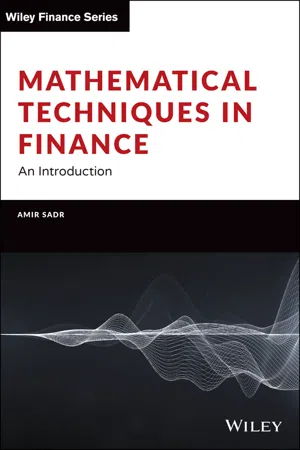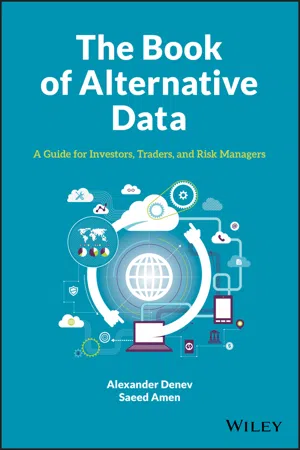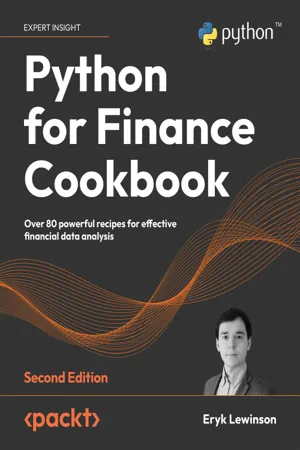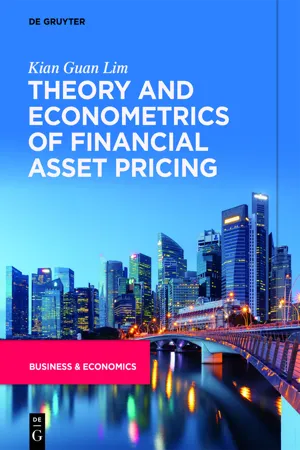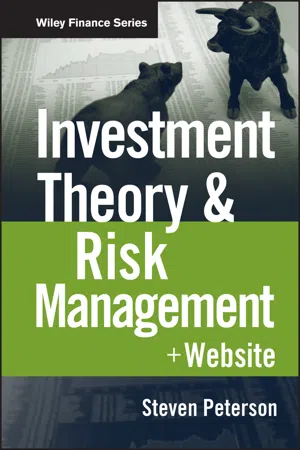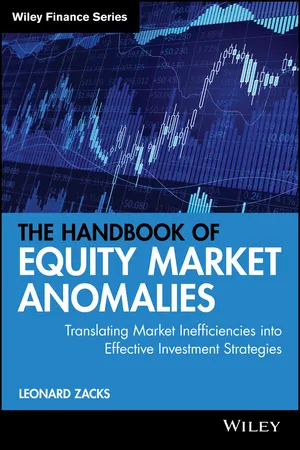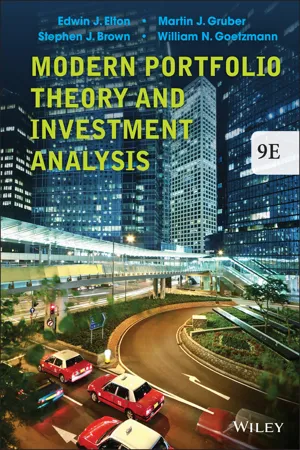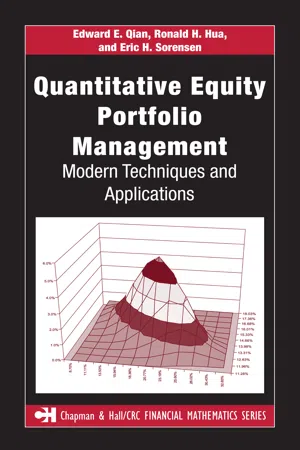Business
Fama French 3 Factor Model
The Fama French 3 Factor Model is an asset pricing model that expands on the Capital Asset Pricing Model (CAPM) by incorporating additional factors: size and value. It suggests that the returns of a portfolio can be explained by exposure to market risk, size risk (small vs. large companies), and value risk (high book-to-market ratio vs. low). This model is widely used in finance to analyze and predict stock returns.
Written by Perlego with AI-assistance
Related key terms
1 of 5
10 Key excerpts on "Fama French 3 Factor Model"
- eBook - PDF
Mathematical Techniques in Finance
An Introduction
- Amir Sadr(Author)
- 2022(Publication Date)
- Wiley(Publisher)
3.4.2 Fama-French Factors The APT conditions for a factor model are applicable to any common driver of excess returns, be they economic or derived from data. A commonly used set of economic factors proposed by Fama and French [Fama and French, 1993] are: ■ Small Minus Big (SMB): It is observed that investments in stocks of com-panies with small market capitalization have historically outperformed investments in large capitalization companies. The SMB factor is based on the return of a representative portfolio of small-cap stocks versus the return of a representative portfolio of large-cap stocks. ■ High Minus Low (HML): The book value of a company is the value of its assets minus its liabilities, referred to as shareholder’s equity in a company’s balance sheet. The book value of a company is often dif-ferent than its market value (price times outstanding shares). Growth stocks tend to have high market value versus their book value, while value stocks have high book value compared to their market value. Value stocks have historically outperformed growth stocks and the HML fac-tor is based on the return of a representative portfolio of value stocks versus the return of a portfolio of growth stocks. The addition of these factors to the market’s excess return gives rise to the Fama-French three-factor econometric model for the excess return of an asset R − R 0 = 𝛼 + 𝛽 M ( R M − R 0 ) + 𝛽 s F SMB + 𝛽 v F HML + 𝜖 (3.22) Additional economic factors, such as operating profitability (robust versus weak, RMW), investments and asset growth (conservative versus aggressive, CMA), and momentum (MOM), have been added to the original factors. 88 MATHEMATICAL TECHNIQUES IN FINANCE 3.4.3 Factor Investing The Fama-French factors are based on the fundamentals attributes of firms such as size, book value, and investments and are plausible explanations of excess returns. - eBook - PDF
The Book of Alternative Data
A Guide for Investors, Traders and Risk Managers
- Alexander Denev, Saeed Amen(Authors)
- 2020(Publication Date)
- Wiley(Publisher)
It is worth noting that, unlike CAPM, APT tells us nothing about what these factors should be or about the sign of each factor’s excess return E [ F j − r f ] . 8 The number and nature of these factors could potentially vary over time and across markets. As a direct influence of the APT, many new multi-factor models were proposed after its publication. We will now examine the most famous of them – the Fama-French model. 6.2.2 The Fama-French 3-Factor Model Fama and French (Fama and French, 1992) developed a widely accepted model and the most successful one so far. We can say that it belongs to the class of hybrid models based on both macroeconomic (the market) and fundamental factors. Fama and French showed that the CAPM fails to adequately explain asset returns cross-sectionally for portfolios consisting of small/large stocks, and of portfolios con-sisting of high/low book-to-market 9 ratio stocks. It tends to underestimate returns for small or high-value stocks and overestimate them for big or low-value stocks. 10 Fama and French used portfolios based on these ratios and time series regression analysis to show the significance of these factors. More specifically they proposed the following model to explain the returns of the portfolios over the risk-free rate: r i , t − r f , t = 𝛼 i + 𝛽 mkt , i ( r m , t − r f , t ) + 𝛽 SMB , i ∗ r SMB , t + 𝛽 HML , i ∗ r HML , t + 𝜀 i , t (6.7) where r i is the return of portfolio i , r f the risk free rate, r m the market return (calculated as the return on the market cap weighted portfolio of all stocks), r SMB the returns of small stocks over big stocks, r HML returns of high-value stocks over low-value stocks, and 𝜀 stochastic error term. The r SMB and r HML are constructed as follows. The stocks universe is partitioned by book-to-market ratio into 3 groups and by market-cap into 2 groups. - No longer available |Learn more
Python for Finance Cookbook
Over 80 powerful recipes for effective financial data analysis, 2nd Edition
- Eryk Lewinson(Author)
- 2022(Publication Date)
- Packt Publishing(Publisher)
In their famous paper, Fama and French expanded the CAPM model by adding two additional factors explaining the excess returns of an asset or portfolio. The factors they considered are:- The market factor (MKT): It measures the excess return of the market, analogical to the one in the CAPM.
- The size factor (SMB; Small Minus Big): It measures the excess return of stocks with a small market cap over those with a large market cap.
- The value factor (HML; High Minus Low): It measures the excess return of value stocks over growth stocks. Value stocks have a high book-to-market ratio, while growth stocks are characterized by a low ratio.
The model can be represented as follows: Or in its simpler form:Please see the See also section for a reference to how the factors are calculated.Here, E(ri ) denotes the expected return on asset i , rf is the risk-free rate (such as a government bond), and is the intercept. The reason for including the intercept is to make sure its value is equal to 0. This confirms that the three-factor model correctly evaluates the relationship between the excess returns and the factors.In the case of a statistically significant, non-zero intercept, the model might not evaluate the asset/portfolio return correctly. However, the authors stated that the three-factor model is “fairly correct,” even when it is unable to pass the statistical test.Due to the popularity of this approach, these factors became collectively known as the Fama-French Factors or the Three-Factor Model - Kian Guan Lim(Author)
- 2022(Publication Date)
- De Gruyter(Publisher)
ˆ for all portfolios.This study suggests that the market beta and two other firm attributes viz. capitalization size and book-to-market equity ratio are three variables that correspond each to a common risk factor affecting the cross-section of stocks. Together with the earlier 1992 study, Fama and French broke completely new and fascinating ground in the world of investment finance by pointing out presumably better explanations for the cross-sectional expected returns of stocks than what single-factor CAPM does. It is in explaining every stock’s return variations that these risk factors are considered as systematic across the market. The new proxies of systematic risk factors they suggested led to voluminous research that followed. Unlike factors linked to macroeconomic variables, these Fama-French risk factors can be constructed like funds that can be traded and used for hedging. Thus, there is greater plausibility in their use by the market, and hence their role as systematic risk factors.Carhart 4-Factor Model19 is an extension of the Fama-French 3-Factor Model to include a momentum factor. The monthly momentum factor is formed by equal-weighted average of returns of highest performing firms in the previous year less the equal-weighted average of returns of the worst performing firms. It is called the winners minus losers or up minus down (UMD) factor. The factor however appeared to reverse correlation in events of momentum crashes during strong economic downturns.Fama and French 5-Factor model20- eBook - ePub
A Fast and Frugal Finance
Bridging Contemporary Behavioral Finance and Ecological Rationality
- William P. Forbes, Aloysius Obinna Igboekwu, Shabnam Mousavi(Authors)
- 2019(Publication Date)
- Academic Press(Publisher)
(6.8) ).Figure 6.4 Plot of the five Fama-French factors.Note: Source: Ken French's personal website in Data Library section. http://mba.tuck.dartmouth.edu/pages/faculty/ken.french/data_library.htmlRejections of the restriction a=0, across all sample companies, could mean inefficiency in pricing with respect of these three/five risk-factors or could mean that some other group of “true” return generating factors lead to investors earning risk-premia on these observed factors, which may, or may not, be the true factor generating variables. This reminds us all asset pricing tests are tests of the joint hypothesis of (a) market efficiency and (b) the particular asset price model considered. The difference in returns to stocks of different sizes, value, profitability, investment intensity and can be shown by examining their returns once ordered in quintile portfolios according to each of these four characteristics, plus overall stock market movements embedded in the market risk–premium,.R−M , tRF , t6.1.3 Difference in shareholder returns across size, value, profitability, and investment portfolios
The difference in returns for value, profitability, and investment intensity is shown within size quintiles in Figs. 6.5 to 6.6 . Looking along the size axis of Fig. 6.5 the premium paid to small, low market–capitalisation companies, regardless of their value/glamour, implied by their book–to–market ratio, is clear.Figure 6.5 Size/Market Capitalisation to Book to Market/“Value” shareholder return profile.Note: Source: Table 1 of Fama and French (2015) , p. 3.Figure 6.6 The distribution of shareholder returns across book–to–market/operating profitability quintiles for smallest (upper figure) biggest (lower figure) quintile of firms.Note: Source: Table 2 of Fama and French (2015) - eBook - ePub
- Steven Peterson(Author)
- 2012(Publication Date)
- Wiley(Publisher)
Chapter 9 Factor ModelsAn economist is someone who sees something in the real world and wonders if it would work in theory.—Ronald ReaganThe CAPM can be interpreted as a single index factor model, and since we are already familiar with it, I will use the CAPM to introduce this important class of pricing models.Factor models can be thought of as models of the conditional mean return to an asset (or portfolio of assets). We used unconditional mean return estimates as inputs to the optimal mean-variance efficient portfolios solved for in Chapters 6 and 7. To understand the difference, letritbe the return on asset i at time t. Then the asset's unconditional mean return is simply the average return, that is, E (ri) = . Now, think of the CAPM model:For ease of exposition, drop the risk-free rate (that is, assume that cash earns no return) and take expectations (see the statistical review in the appendix to Chapter 5) noting that E (εi ) = 0 by definition. Then,Simply stated, this says that the expected return is now conditional on the market return. The market return is therefore the single factor and beta is the return (sometimes called the factor loading ) to that factor.There are several attractive features of factor models that are developed in this chapter, but the first and most obvious feature is that factors help attribute the asset's return to movements in specific underlying sources of risk and return. The Fama-French three-factor model introduced in Chapter 8, for example, decomposes the asset's return into three component parts—the return attributable to the value portfolio (HML), the return attributable to market capitalization or size (SMB), and the market return:Since the factors themselves are returns, then the factor returns (the betas) measure the return attributable to the asset's exposure to each of these factors. Thus, a 1 percent change in the factor is expected to move the asset's return by the amount of its beta with respect to that factor. The parameters of factor models are generally estimated by ordinary least squares available in virtually all spreadsheet and statistical software packages. Thus, collecting a time series of returns on the asset and the factors (the latter are available at French's website) then regressingri - eBook - ePub
The Handbook of Equity Market Anomalies
Translating Market Inefficiencies into Effective Investment Strategies
- Leonard Zacks(Author)
- 2011(Publication Date)
- Wiley(Publisher)
Security Analysis. Formal statistical tests of the value anomaly were performed by Stattman (1980) and Rosenberg (1985), who used the book-to-market ratio as a value indicator. Basu (1977) discovered an alternative version of the value anomaly using the E/P ratio. Jointly, the size and value anomalies were considered by Fama and French (1992) who argued that the cross-sectional variation in stock returns is completely captured by size and BE/ME, but not by market beta, leverage, or the E/P ratio.Fama-French Three-Factor ModelThe Fama-French risk model was developed as an extension of the CAPM that can explain the value and size anomalies. In a seminal paper, Fama and French (1993) suggest two new risk factors: the difference in returns on portfolios with high book-to-market and low book-to-market ratios (HML) and the difference in returns on portfolios with small stocks and large stocks (SMB). They show that the size premium and the value premium can be considered as a compensation for risk related to these new factors. In this sense, the Fama-French model provides a risk-based explanation for the anomalies and claims that the abnormal returns for small and value stocks are associated with high betas of these stocks with respect to the HML and SMB factors.Value Anomaly: Risk or Mispricing?The interpretation of HML and SMB as risk factors has stimulated an active discussion whether higher returns on value stocks and small stocks indeed represent a compensation for risk (i.e., are related to stock betas) or should be attributed to mispricing caused by various investors’ behavioral biases (i.e., are associated with the stock characteristics).There are a number of possible psychological reasons why investors might overvalue growth stocks and undervalue value stocks. First, investors may give too much weight to past performance; in general, growth stocks have high historical growth. It is possible that investors project past performance too far into the future, overvaluing growth stocks and undervaluing value stocks. Second, it is possible that investors choose to invest in good companies regardless of whether those companies are fairly priced, that is, they overpay for growth. Third, it is possible that greater media or analyst coverage of growth stocks convinces investors that they are better investments. - Edwin J. Elton, Martin J. Gruber, Stephen J. Brown, William N. Goetzmann(Authors)
- 2013(Publication Date)
- Wiley(Publisher)
Source: Data courtesy of Kenneth French. investors to hold these portfolios or simply evidence that premiums shift through time is an open question. 392 PART 3 MODELS OF EQUILIBRIUM IN THE CAPITAL MARKETS Annualized Summary Statistics for Fama, French, and Carhart Factors, 1927–2011 Standard Geometric Arithmetic Deviation Mean (%) Mean (%) (%) Factor MOM 6.91 8.60 18.09 Rm-Rf 5.70 7.58 20.31 HML 3.30 4.13 13.42 SMB 2.54 3.16 11.57 The summary statistics for the factors show that, whereas the mean of the value and size factors is lower, their volatility is lower as well. This is because MOM, HML, and SMB are constructed from a long position in one portfolio of equities and a short position in another. We would thus expect them to be less volatile than a long-stock short Treasury bill portfolio like the equity premium Rm-Rf. Ang and Kjaer (2011) and Blitz, Huij, and Steenkamp (2012), among others, argue that fac- tor investing is a good long-horizon strategy, particularly for institutions that are not sensitive to occasional periods of poor returns. In a world where factor premia reflect aggregate aver- sion for exposure to the factor, an investor willing to accept factor risk may, over the long term, “harvest” the premia. Ang, Goetzmann, and Schaefer (2009) recommended a factor investing approach for the Norwegian sovereign wealth fund which invests for future generations of the Norwegian people. They propose a set of equity and fixed-income factors that have generated historical premia. The factor descriptions that follow are adapted from their 2009 report.- eBook - PDF
Quantitative Equity Portfolio Management
Modern Techniques and Applications
- Edward E. Qian, Ronald H. Hua, Eric H. Sorensen(Authors)
- 2007(Publication Date)
- Chapman and Hall/CRC(Publisher)
For example, Fama and French (1992) proposed a three-factor model with beta, market capitalization, and book-to-price ratio to describe prices. But from the practitioners’ point of view, this simply indi-cates that there exist other priced factors in addition to the market beta. Still, risk models should encompass more. Specifically, some factors may not be priced or rewarded unconditionally through time, but they do dif-ferentiate cross-sectional security returns. In other words, it is conceivable to assume that there are nonpriced risk factors whose returns exhibit a low unconditional mean but high unconditional variance. Finding other priced factors would improve the descriptive accuracy of CAPM as a pric-ing model, but it would carry little implication for risk modeling. As a consequence, many practitioners use arbitrage pricing theory (APT) to model risk models by incorporating a set of nonpriced risk factors in addi-tion to priced factors, thereby constructing risk-adjusted portfolios and managing portfolio risk in general. As readers shall discover later in the book, many alpha models take on the same form as the risk models. This is the approach we take in this book. In this chapter, we will introduce multifactor risk models that are based on APT. We first briefly describe the APT model. Then, we outline three different variants of mul-tifactor models: macroeconomic factor model, fundamental factor model, and statistical factor model. We also present concepts of risk contribution, which are important in risk management practice. 3.1 ARBITRAGE PRICING THEORY AND APT MODELS APT has two main ingredients. The first is an assumption regarding the security-return-generating process, and the second is the law of one price — two identical items must have the same price. The return-generating pro-cess requires that returns of any stocks be linearly related to a set of factors or indices r b b I b I i i i iK K i = + + + + 0 1 1 L ε . - eBook - ePub
Market Momentum
Theory and Practice
- Stephen Satchell, Andrew Grant(Authors)
- 2020(Publication Date)
- Wiley(Publisher)
The use of NYSE breakpoints, but equities across multiple exchanges, means that the first column in the table will not (generally) have the same number of elements as the second (big stocks are ‘big’ across all exchanges, in other words). We next discuss some academic research in which sorting has been identified as pertinent.Lambert and Hübner (2014) present a critique of the sorting methods of Fama-French, arguing that the value premium may be mis-specified, and is driven by the sorting rather than as compensation for risk. They prefer a procedure that is based on conditioning arguments, which leads to alternative estimates of risk premia. The key change in the context of this chapter is the replacement of independent sorting with sequential sorting.Cremers et al. (2012) discuss differences between practitioner-oriented studies (that primarily use broad index-based benchmarks) and academic studies (that prefer to use Fama-French factor model benchmarks). For instance, Cremers et al. (2012) examine the return to the S&P500 index (a common benchmark for mutual funds) against a Carhart four-factor benchmark, and find a positive and significant annual alpha of 0.82% p.a. for the period 1980 to 2005. They attribute this finding to three sources. Firstly, in the size/book-to-market independent sorts in the Fama-French data set, portfolios are equally weighted when constructing SMB and HML factors. This overweights small stocks relative to a market capitalization-weighted index.Secondly, the market index is proxied by the CRSP value-weighted index, which includes assets outside the universe of US Common stocks (such as Real Estate Investment Trusts [REITs] and American Depositary Receipts [ADRs]), which have underperformed the S&P500. Cremers et al. (2012) also suggest that index rebalancing effects of broad stock indices exacerbate return differences compared with the CRSP index. The main finding of the Cremers et al. (2012) study is that by using appropriate weighting schemes (value weighting stocks within portfolios) and investable benchmarks, out-of-sample tracking error volatility is reduced substantially. This reflects the fact that, in part, desirable criteria of a model used for asset pricing purposes (i.e. linear factor models) are not identical to those of a model used as a benchmark for fund managers (where the hurdle is the passive investment return).
Index pages curate the most relevant extracts from our library of academic textbooks. They’ve been created using an in-house natural language model (NLM), each adding context and meaning to key research topics.
